5 Steps Of The Writing Process
As an Amazon Associate I earn from qualifying purchases. Thank you for your support!
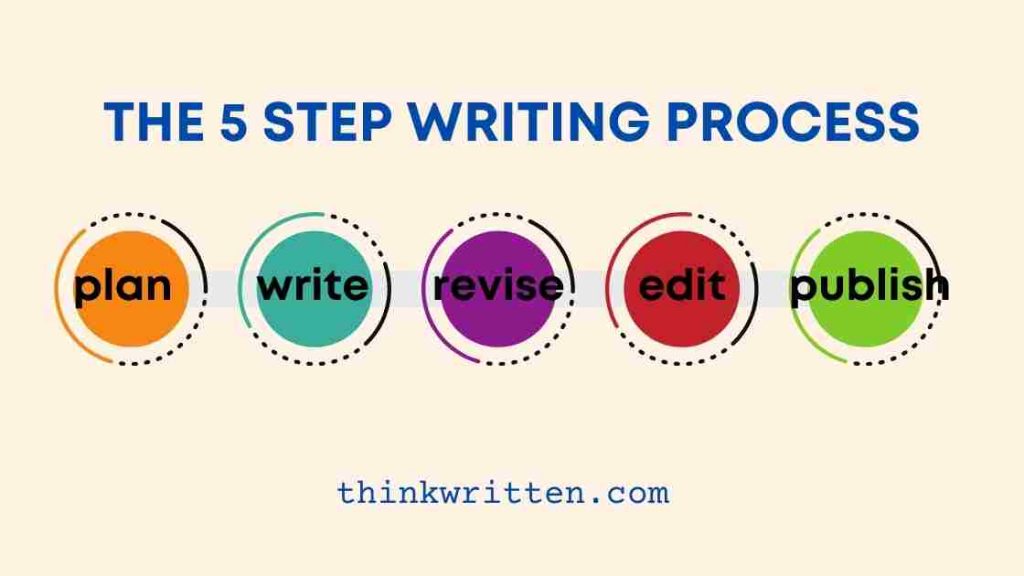
When it comes to the writing process, there are 5 steps that you need to know as a writer. It's not as simple as just slapping down some words onto a page – there is a method that just straight up works.
In today's post we are going to break down the 5 steps of the writing process so you can learn how to write more efficiently and share your words with the world.
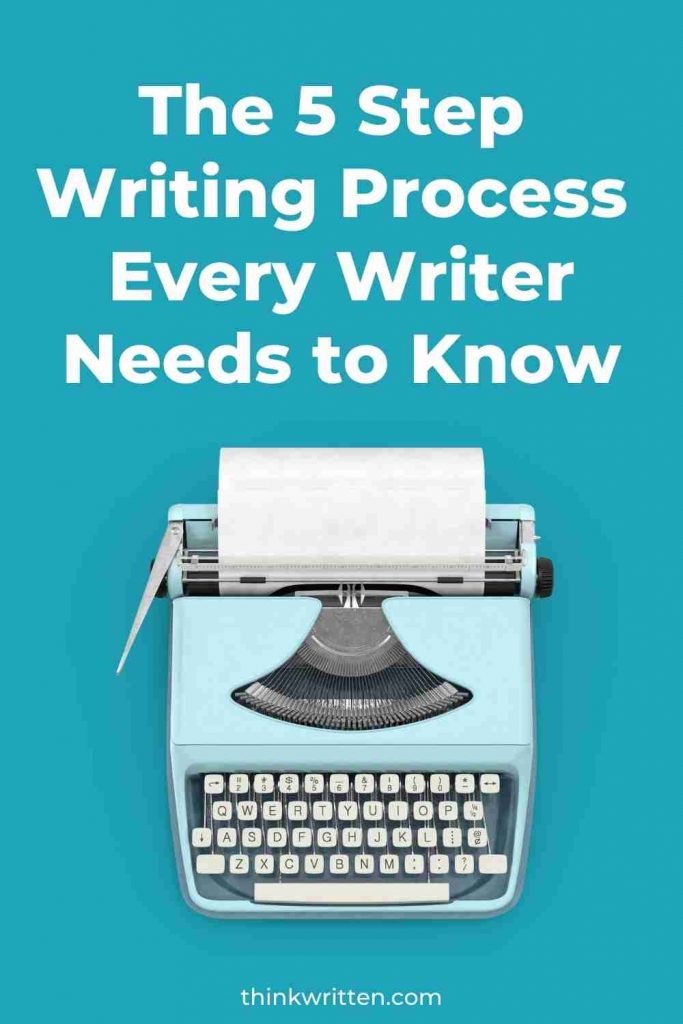
Introduction to the 5 Steps of Writing
Everything is a process, from how you make a peanut butter and jelly sandwich to assembling a low-earth orbit space telescope.
The key thing, as any project manager or business analyst will tell you, is to define the core parts of the process and establish what is called the Critical Path – the series of steps that must be completed, one before the other, and the order in which they have to proceed.
When it comes to writing, the same order of operations has to be followed, from the shortest flash fiction to the longest epic saga, to produce a fully realized text.
The five steps of the writing process are Planning, Writing the first draft, Revising, Editing and Proofreading, and Publishing.
Let's make this a nice and neat bulleted list for those of you who just want your fast facts about the 5 step writing process:
- Prewriting and Planning: The prep work you do before you write.
- Writing: The stage where you write your first rough draft.
- Revising: This is where you make structural changes to your work and make sure your story is solid with no inconsistencies or holes in the plot.
- Editing and Proofreading: This is where we get down to the nitty gritty of grammar, spelling and style.
- Publishing: The final step when you release your work into the wild for the world to read.
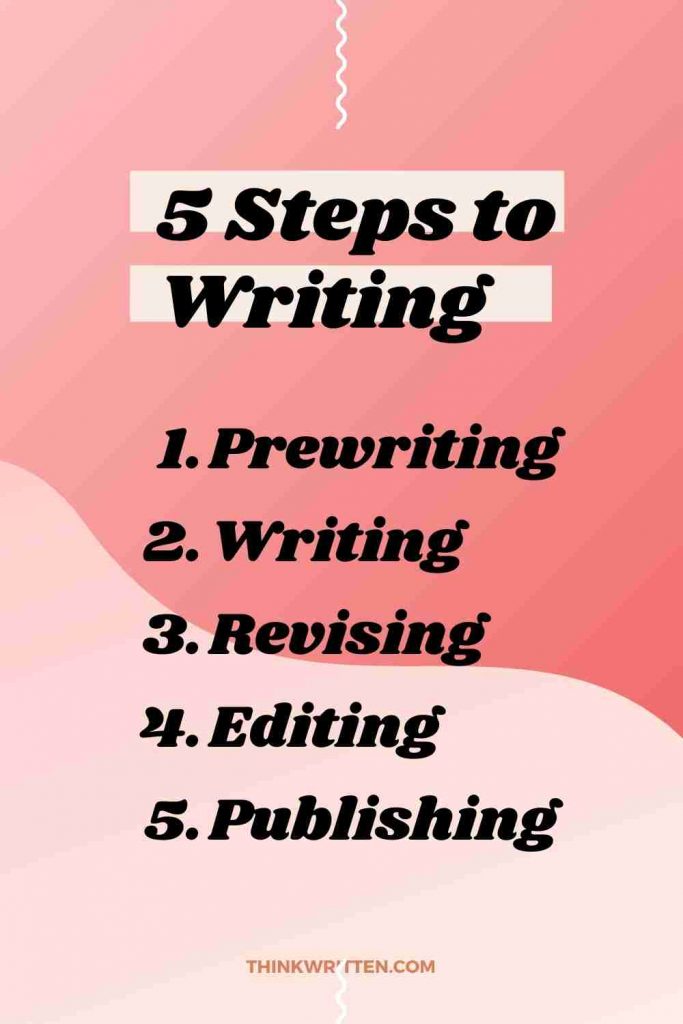
Each of these steps can be broken down into several parts, which we will cover in the paragraphs that follow.
Now, some of you may be thinking "Bill, this is nonsense. My process is organic; just goes with the flow, man." And that's fine. This article isn't for you. You can go and be James Joyce putting out seven words a day and then wonder what order they're supposed to go in.
The rest of us will go be writers and command our work in a manner that actually, you know – WORKS.
If you're serious about finding a writing process that will make you a more efficient writer and help you turn out your best work, keep reading.
Strap in. This is going to be a long ride.
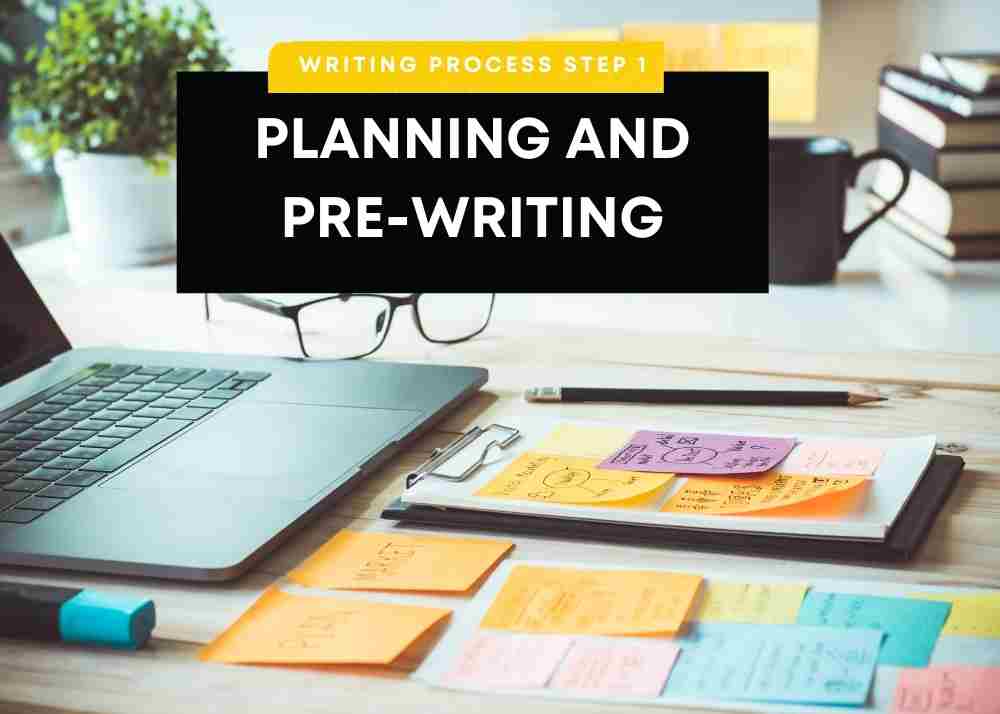
Step 1: Planning and Prewriting
You know the saying: "Those who fail to plan, plan to fail." If I had a nickel for every time I heard my father say this phrase, I could have gotten through grad school without the loans.
As obvious as it is, it is still very true. It is one of those lessons that transcends disciplines, and is as easily applicable in the arts as it is the sciences. When we talk about planning for the written word, there are a few things it usually implies.
Here are some things you need to do in order to make sure you are maximizing the planning step of the writing process:
Preparation of Self and Space
You have to be ready mentally to dive into your writing, which means you need to plan a space and a schedule during which you will pursue your craft.
This can be anywhere or any time that you choose, but, for the best results, it needs to be consistent. Same place, same time, and for the same amount of time every day.
Free yourself from as many distractions as possible – that means no TV droning on in the background; no exceptions. No news, no game shows, no dramas, no nothing.
You need some kind of noise? Music is a great friend for that. Depending on what I am working on, I have a few playlists I work with.
When I am writing for my own nefarious purposes (read: working on my fantasy/sci-fi/horror fiction), I usually stick with a lot of metal music – Metallica, Amon Amarth, Sabaton, Blind Guardian, Lacuna Coil, and Pantera are a few favorites.
If I'm working on something more on the noir end of the spectrum, I'll play some B.B. King or John Lee Hooker.
As I'm working on this article, I am listening to some Classic Rock favorites (AC/DC, Led Zeppelin, The Rolling Stones).
Music helps me to set the mood for writing and guides my brain into the right groove. And since I typically know what I will be writing about, I can tailor that experience to improve my focus.
You could also do a million times worse than shutting off the internet to your computer (if that is how you are doing your writing) and leaving your cellphone in a drawer on the other side of the room. The rest of the world can wait.
You didn't come into this space to play Candy Crush or surf social media. You're here to work, Writer. The games and drama of people on the internet will be there when you're done; I promise.
If you struggle with distraction while writing, see our post on 12 Tips for Distraction Free Writing for some ideas on how to get your work done in half the time.
Also, make sure your writing space is comfortable. Seriously, get an ergonomic office chair for writers – it's worth the splurge!

Gabrylly Ergonomic Mesh Office Chair, High Back Desk Chair - Adjustable Headrest with Flip-Up Arms, Tilt Function, Lumbar Support and PU Wheels, Swivel Computer Task Chair, Grey
$329.50
$289.50 in stock
2 used from $246.37
Free shipping
as of November 11, 2021 5:29 pm
Preparation of Material
So. What are you going to write about? Do you know? Do you have an idea of where it is going and how long it will take to get there? Do you have a list of settings? Chapter summaries? Character profiles? Relevant research?
Oh, did you think we weren't working?
A lot of what goes into good writing is preparing for what you are about to write.
Yes, there are writers out there that don't necessarily need a legal pad full of notes to write a story, and you may not either, depending on what story you are going to tell.
But if you are going to write a tale of high seas adventure and can't tell port (left) from starboard (right) or fore (front) from aft (rear) or what does it actually mean to be amidships (the middle of a ship, either laterally or longitudinally), your results are going to be less than stellar.
When it comes to characters and settings, it's okay to go into this process with just a general idea of what the main characters are like. Of course, this isn't a bad time to ask yourself some important character development questions either.
During this phase of the 5 step writing process, you'll discover other less central characters and more facts about your protagonist/antagonist/deuteragonists and the world they inhabit as you tell their stories.
You don't need to know everything – that would be boring – but you need to take some time to figure out what you need to know.
For example – I like to occasionally write detective stories. I have never personally been a detective.
I studied law and evidentiary standards and trial procedure in undergrad while working the pre-law track of my English degree. There were bits and pieces I knew, and some gaps that I had erroneously filled with television police procedural nonsense (another reason to shoot your set – it's making you think you know things you don't know!), and the rest I filled in with research.
I picked through crime scene manuals, forensic science books, books on criminal profiling and common investigative techniques, and pored over books of case law concerning the kinds of crimes my detective was going to be investigating.
I actually have a large journal with over a hundred pages of notes and observations, drawings of the fictional crime scenes, and so on for a story I was working on some time ago. (Learn how to create and use a writers notebook here!}
And this is where the caveat is introduced – don't spend so much time researching that you forget to write the story.
Knowing what you need to know will get you where you need to be. You don't have to become a detective to write compelling fiction in that genre. And what if you write it and it's wrong? We'll get to that later in the writing process.
Step 2: Writing the First Draft
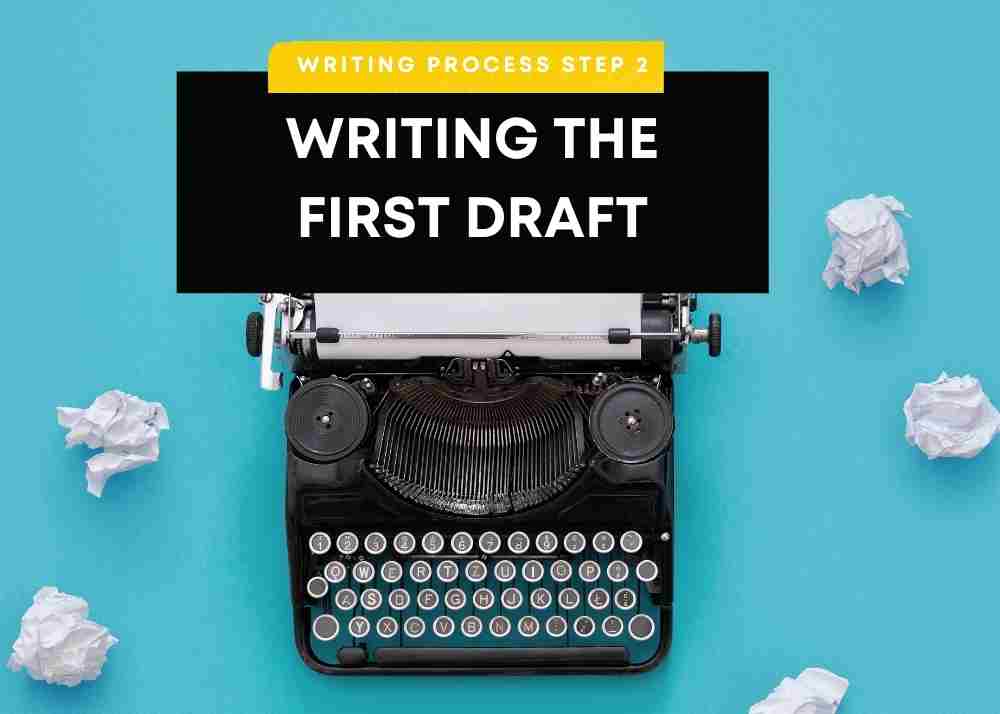
Our second step of the writing process is what all of us as writers love: actually writing.
Putting words to paper is one of the most satisfying feelings I have ever experienced. Seeing all that lovely white space disappear behind rows and rows of text; feeling a story progress through the layers of development into a fully fledged narrative; watching my characters learn and grow as they surmount challenges or face the heartache of failure.
This is where the magic happens; it's where the story begins to reveal itself. And like everything else, there are some guidelines to follow. Here are some things to remember when writing in Step 2 of the writing process:
Stay Focused
The story is in charge. You need to let the story dictate what you are going to do.
And as I have said before, try to keep to a schedule that works for you.
Some of you are morning people. I am not. I do my best work in the evening after my daughter has gone to bed. My wife will unwind in the living room with a movie or one of her favorite television shows, and I will take my laptop to the next room over to put myself in the zone.
I don't shut the door, but you should keep your space as closed to the outside world as possible. That can mean putting on some really good headphones to listen to music or just cancel out external noises, but you need to eliminate as many distractions as possible.
Your goal when you start writing is to produce a complete First Draft of your story, and to that end you should do your level best to get straight through it.
Of course, distractions don't just come from outside the writing environment. Sometimes they come from inside as well.
Don't Edit While You Write
You will be tempted to reread your entire work up to that point and revel in its greatness. Don't, because…
You will be tempted to tweak a passage that you now find lacks the force you thought it had. Don't, because…
You will be tempted to rethink an entire plot line and potentially scrap an entire chapter of work. Don't, because…
You will start to question the worthiness of how you have presented the story and then the story itself.
As we talk about in our article on How to Write 2,500 Words a Day, you don't ever want to go back and start editing or tweaking in this stage of the writing process.
Here is what you need to remember: The First Draft is not the whole story. It is not where the creative process ends. It is important, though, because it is the first step in making your written work what you want it to be.
It doesn't need to be done perfect; it just needs to be done.
With regard to us as writers, it is very easy to get sucked into the world of "what ifs" and lose our pathway to the end of the story.
Like the dwarves in J.R.R. Tolkien's The Hobbit, we get lost in Mirkwood, unable to envision an end to our perilous journey; unable even to remember why we were on this journey in the first place. Keep above the trees, my friend, and keep yourself pointed at the goal.
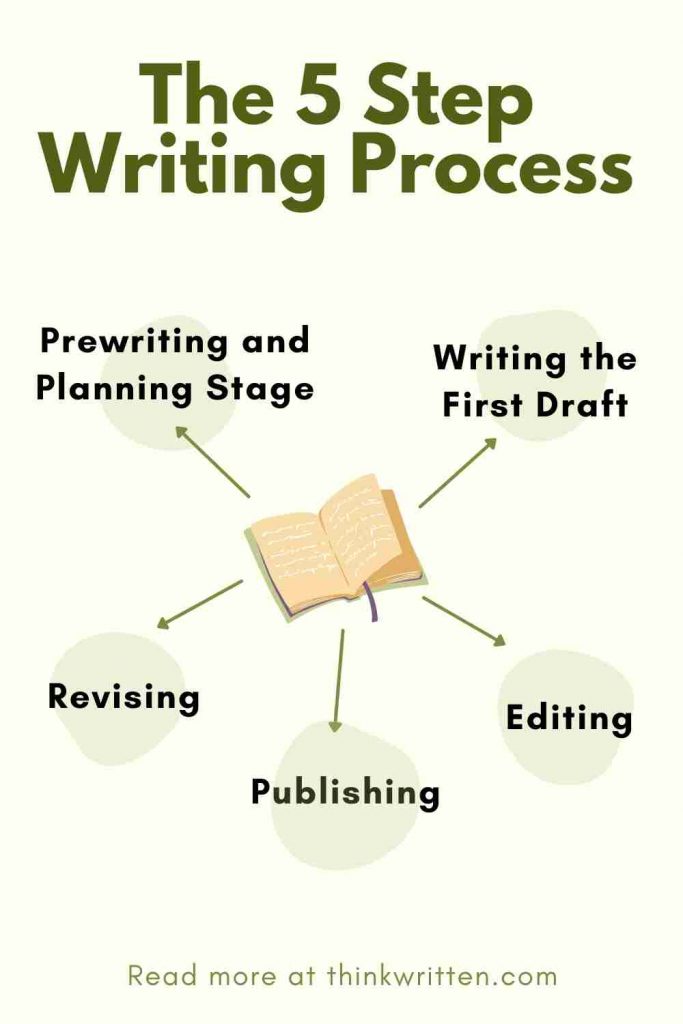
Stay Organized
One way to help keep your eye on the prize is to be sure to keep notes concerning your characters and settings, and also to make little synopses of chapters as you go.
The temptation to reread your own material is going to be very real, so if something happens where you break your schedule and you need a refresher of where you were last, you can refer back to your notes and journal entries to find your bearings.
Personally, I use Microsoft OneNote to keep track of my notes and journal entries while writing. It's free, which is my favorite price for everything, and it lets you create a structure for your notes that makes sense.
Keeping separate sections for settings, character details, chapter synopses, and personal thoughts at the end of each writing session (which I will wholly ignore once put down until we get to the next step in the process) will give you a quickly searchable reference guide to your own work later on.
Any similar tool will work, or, in lieu of a digital work space, a good five subject notebook will help to keep you organized. I like the idea of working longhand, and often do, but my handwriting is at its worst when my brain is at its fastest, and so for me it makes sense to keep it digital.
Step 3: Revision
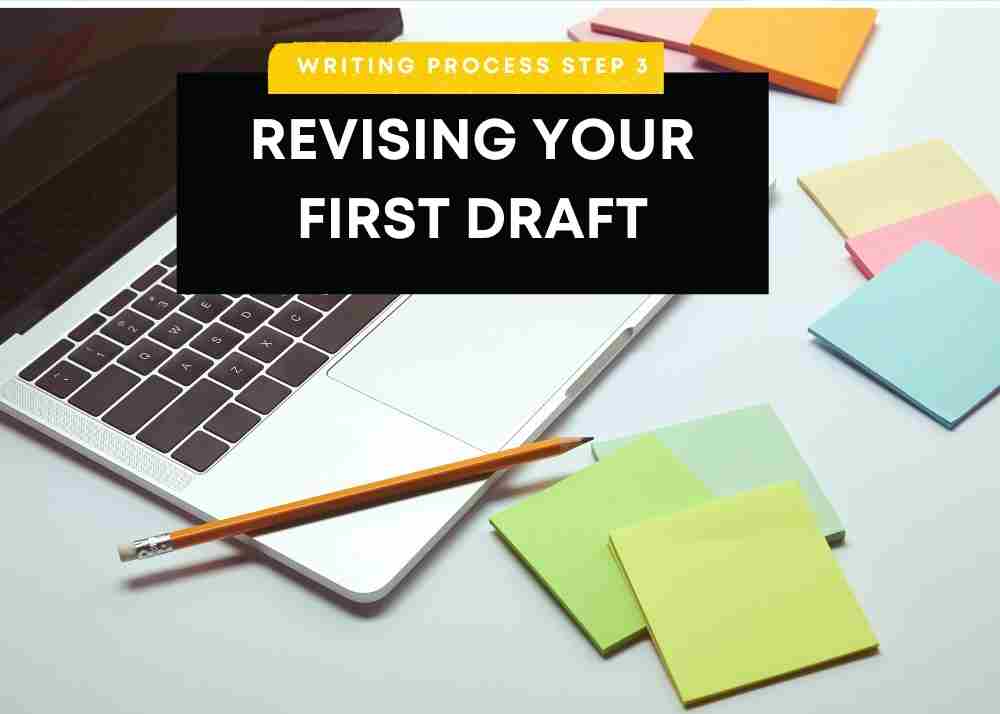
So, you have officially completed the first draft of your manuscript. Congratulations! Great job! It is time to celebrate! Once you are done it's time to take that completed work and…wait.
What?
Chill.
At this stage in the writing process, you need to wait.
Depending on the size of the manuscript you've produced, which will depend on what you are writing about and the format, you will want to sit on that bit of glory for a minute before you dig into the next phase.
How long? A day to three weeks would be ideal, with the shorter works (essays, flash fiction, etc) requiring the least amount of time to wait. Your Great American Novels require the longer period.
What you do during this waiting period is up to you – some may prefer to dig in and start on another work, others might take some time to read a few pieces in your market.
But what you are not allowed to do is anything related to the manuscript you just finished, including writing about the piece or reading any of your notes. Stuff it in a drawer and pretend it doesn't exist.
You see, the third stage of the writing process is the revision process. It's at this time where we will start working with the story again and going through any possible holes in the plot.
You cannot possibly do this well when the work is still fresh in your mind. You need to give it some space so you can clear your head and approach it with an unbiased mind.
The key here is to give the piece enough time to ferment that when you finally return to it, you do so with fresh eyes and a kind of separation from the piece.
The revision process of writing requires you to be objective, and that isn't always possible when it comes to your darling text.
This is your baby, after all, and, like with children, it will be hard for you to see it in a light other than positive (or extremely negative) without first putting a wedge of objectivity between you and it.
Once the waiting period is over, you're ready to really get into revising. Here's some things to remember:
Read Straight Through Your Work Without Making Changes First
Yes. You read that right as well.
Once your prescribed cool-down time has been reached, it is time to crack the sarcophagus on that manuscript and take a gander.
As best as you are able, get through the whole thing in one sitting. Take notes (on a separate document, referencing page and paragraph numbers).
By now, you should be distanced well enough from the work to be able to put it under the microscope and extract those things that don't belong, but also hook onto those things that really shine and think of ways to enhance them.
Like with writing your first draft, it is important to power through it. Don't make the changes yet, just get a good idea of what needs done.
Kill Your Darlings
Once you've read through, it is time for the hard part. Taking stuff out.
When you write your first draft, you are telling the story to yourself. When you go through to make revisions, your job is to remove all the things that are not the story.
Places where you tell instead of show, or where you maybe are showing off a little too much with you research, or a sentence/paragraph/dialog/chapter that makes no sense in relation to the rest of the work, need to be removed.
You are going to run across some stunning prose in your journey of revision, not all of which belongs to the story. And that is where it gets difficult.
Your initial feeling might be to shoe-horn it in somehow, or just to leave it because "It's just so good!" You have to fight this urge. The story doesn't exist as a means for you to show off. The story is in charge – don't forget that!
Add What's Necessary
You are also going to come across some parts of your work that might need some additional build-out – more description, sharpening details, putting in something you realized you forgot on the first draft that is vital to the story.
It is also a chance to highlight some of the naturally occurring symbolism in your narrative (don't go forcing symbolism, though; it never works the way you want it to) and add a little flourish here and there.
Remove Inconsistencies, Redundancies, and Unnecessaries
There is a good little equation to remember when revising:
Final draft = First Draft – 10%
This is the basic formula we're looking for. If the first draft of your text is 50,000 words, you should strive to reduce that to 45,000 through the process of revision.
That does not mean removing chunks of narrative indiscriminately. On the contrary.
As I mentioned earlier, our job during revision is to remove everything that is not the story, and that means removing things that don't fit or otherwise don't need to be there.
While Revising, there are three basic things to look for:
Inconsistencies:
this is the biggest problem and the reason why you should take notes as you write concerning your settings and characters.
If a room in chapter one has a curio cabinet full of geological trinkets, but is full of Beanie Babies in chapter seven, that is an inconsistency that the reader is going to notice.
If a change like that is going to happen, there needs to be a reason, and it needs to further the story. Otherwise, cut it out.
The same is true if you read your protagonist acting in a way that is completely out of character for them – or any character doing so.
A lot of the connection you have with the reader depends on suspension of disbelief – which is not going to happen if your morally rigid main character does something suddenly of ambiguous moral distinction.
Redundancies:
Did your character tell the same piece of back story twice? Did you repeat something else in a specific scene? Do you have two bars in the same town with the same name? Change it or get rid of it. Duplication makes your story less interesting.
Unnecessaries:
This is anything else that is not the story or in service to the story. Get rid of it. Even if the prose is brilliant, or it showcases your amazing research, or it was fun to write.
Don't Go Alone
This is also the time when you can start introducing your work to other readers. In fact, I would encourage it. Find a colleague or two you can trust to be honest in their assessment and let them read your work.
Seek their feedback and, if it makes sense, implement it. You ostensibly wrote your manuscript with the intent to share it with others – test your readership and see what comes back your way.
The only rule is this – you aren't allowed to ask about it until after they are done reading. Don't be so needy. Give them some space.
If possible, join a writer's group. They are going to be far more objective and unbiased that family members or friends.
For more tips on the revising process in writing, be sure to check out our article on 8 Tips for Revising Your Work.
Step 4: Editing and Proofreading Your Final Draft

The third step of the writing process is editing and proofreading.
"Bill, isn't proofreading and editing the same thing as revising?"
No.
First, revising is the process by which a writer examines their work as a whole object – the completed narrative. You will go through several passes of revision before you come to this final step in the process of creating your completed work.
Only once you are totally satisfied with the story as a whole being, that is when you need to make one last pass through your work to tighten every screw.
Proofreading is the third step of the writing process where we start worrying about things like grammar, spelling and punctuation. Your story should be solid at this point – now we're just making sure it is legible.
Here is the difference between revising and editing, just to be clear we're on the same page.
Here are some tips for the proofreading and editing stage of the process:
Slow Down
Proofreading is the phase of the process where you go over your work with a fine-toothed comb. You are no longer reading to make sure things make sense. You've done enough of that.
This is the mechanical inspection of your work to make sure that you're using the proper versions of you're/your/yore, or/oar/ore, their/there/they're, etc.
Because this part of the process requires you to stop thinking in terms of the story, you need to take measures to slow your pace significantly to avoid reading for pleasures and missing some error.
If the piece is short enough, this isn't a problem. If you've written a novel or novella, however, then it becomes more difficult.
When I have done revision and proofreading for other people's manuscripts, I will do a single quick read-through of the entire work to get a feel for the writer's voice. Then I do the editing by reading the work backwards to keep my brain from engaging with the story on too intimate a basis. This trick can work for you as well.
Have Your Toolkit Handy
It takes a special kind of person to remember all the grammatical and linguistic rules for any language, English or otherwise. That said, it is a good idea to have some resources available to help with this process: a dictionary, a thesaurus, and a style manual.
Your Dictionary
![[Paperback Oxford English Dictionary] [By: oxford university press] [January, 2012]](https://m.media-amazon.com/images/I/41INyanbMsL._SL500_.jpg)
[Paperback Oxford English Dictionary] [By: oxford university press] [January, 2012]
out of stock
as of November 11, 2021 5:29 pm
A dictionary is an obvious choice, and my recommendation is the Oxford English Dictionary (the American desk reference, not this 20 volume set that I would love to own if I had the space and the budget).

The Oxford English Dictionary, Volume 1-20, (20 Volume Set)
$1,448.82 in stock
4 new from $1,285.00
3 used from $899.99
as of November 11, 2021 5:29 pm
You need to know how to spell words and what they mean so that you are using them properly.
If you describe someone as solipsistic, but don't know that it can mean someone who is very self-centered, or the philosophical concept that only the self can be known, then you could either use it out of context or just plain incorrectly.
Yes, spellcheck is a thing, but it's not always accurate. Software developers will ensure that the most commonly used words are in the database, but it's up to you to fill in the blank spots.
Thesaurus
A thesaurus is another excellent tool to have, and once more I turn to Oxford with their Writer's Thesaurus , which gives example sentences for words and synonyms, plus assistance on picking the right word for a given situation.

Oxford American Writer's Thesaurus
$41.95
$28.66 in stock
21 new from $28.66
21 used from $16.99
Free shipping
as of November 11, 2021 5:29 pm
The reason you need a thesaurus during the proofreading phase is to eliminate a few more of those redundancies we mentioned earlier.
Nothing is more distracting when reading than a writer who uses the same word over and over again. If you find yourself doing this, take a gander at the thesaurus and use an alternate word.
A Style Manual
A style manual is just a reference for the rules of grammar. In my eye, there can be none better than Strunk and White's Elements of Style .

The Elements of Style, Fourth Edition
$14.99
$9.49 in stock
25 new from $5.93
352 used from $0.94
Free shipping
as of November 11, 2021 5:29 pm
I was introduced to this little book (and it is small) in 10th grade and dismissed it until I started taking writing seriously in my early 20s.
It is by far the most succinct, comprehensive references on English grammar ever to be set down.
I have read through style manuals of many kinds – MLA, AP, Chicago, APA – and had to use all of them. But I always come back to Elements in the end, and save the others for how to cite my references.
These tools will serve you very well in the proofreading stage of the writing process. Don't be tempted to solely rely on your word processing software to catch every mistake.
Consider an Editor at This Stage
An editor is someone who can help you with the proofreading process. It is very easy for us to overlook our mistakes in our writing. Having a professional set of eyes on your work may make all the difference in whether your manuscript is accepted.
Step 4: Publishing Your Work
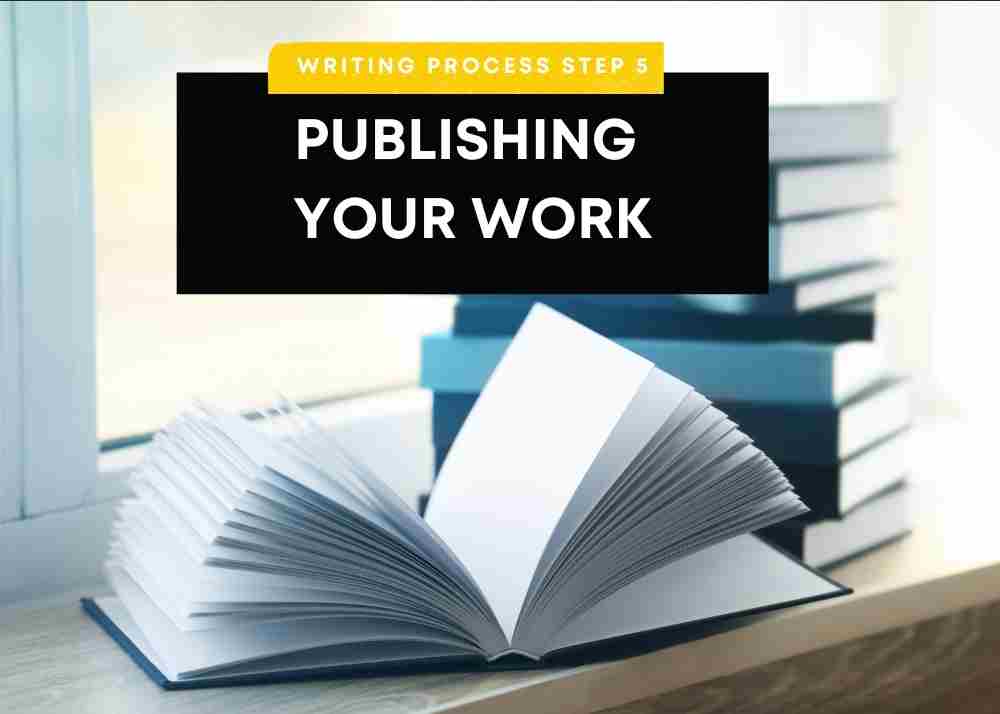
Congratulations! You have finished planning, writing, rewriting, and editing your work. You are ready for the final stage of the writing process, which is publishing your work.
Your test readers have given you rave reviews and lots of constructive criticism. Being the wise author that you are, you have taken this to heart and used their feedback to make your work even better. So how do you get your work in front of other people?
There are two main types of publishing to consider, which are traditional publishing and self publishing. For detailed information on how to publish your work, check out our post on How to Publish a Book that outlines everything you need to do step by step in detail.
When publishing, you need to think about what you wrote and where it will best meet your target audience. If you are publishing on your own blog, it's as simple as just hitting the "Publish" button once the work is ready to release in the wild.
Of course, most of us want to reach a wider scope of an audience than just our blog readers. This is where we have to consider the pros and cons between traditional publishing and self publishing.
Traditional Publishing
The standard way is to shop your manuscript around to publishers that service your genre. Get a copy of Writer's Marketplace and sift through the columns of publishers and literary agents to find your best matches.
The current versions of Marketplace will usually give some insight into whether or not a publisher is willing to work with new authors (assuming this is your first time around the publishing track), as well as how they accept entries.
If you are set in getting your work seen in print or you want to publish with established websites that have an entire editorial staff, you are going to need to consider the traditional publishing route.
Note that the major publishing houses will not take any type of unsolicited manuscript and require you work directly with an agent who submits your work on your behalf.
When you submit your manuscript, never send the whole thing. Follow the directions the publisher specifies!
Usually this means you will send only a few sample chapters, typically the first three. If they like your work, they'll ask to read the whole thing.
If they make an offer, be sure to have a good look at anything requiring your signature.
Small journals may only make you sign a release to allow them to publish the work, and throw in a rider that allows you to keep overall publishing rights.
Bigger publishing houses, dealing with bigger texts will likely have much more complicated contracts requiring you to hire some kind of representation, be it a literary agent or a lawyer.
I would recommend the former if you are going to shop around a big manuscript as they will have a better understanding of the market and the publishers themselves.
Self Publishing
Of course, self publishing is a very popular option nowadays as well. You get none of the hassle of working with a professional publisher, but also none of the marketing and coverage that they provide.
There are many advantages to self publishing if you already have an audience and platform. If you have a site like this one where you are getting hundreds of thousands of visitors a month, you probably don't have to rely too much on any marketing a traditional publisher might provide.
Amazon will let you publish your work electronically, should you choose, and there are a host of hard-bound self-publishing firms out there now as well.
Just remember, what you save in hassle, you lose in selling assistance, access to larger markets and marketing, and you have to foot the bill yourself.
One thing that is very important is you do not confuse self publishing with vanity publishers. Vanity publishers are very predatory in nature and often prey on very mediocre at best authors who simply just want to see their name in print. The costs can be outrageous with them, so do your homework!
Depending on your goal for your work, self publishing can be a great way to get started, and if your work sells well on Amazon under the self-publishing banner, it could still get picked up for wider distribution by another, larger publisher. The sky is the limit!
I hope this article on the 5 steps of the writing process is helpful for you. I know this is a lot to take in all at once but it will be worth it when you slow down and have a method to keep you on track and get your work read by others.
Do you have any questions or comments about the 5 step writing process? Share your thoughts in the comments section below!
5 Steps Of The Writing Process
Source: https://thinkwritten.com/5-step-writing-process/
Posted by: wolfesaper1974.blogspot.com

0 Response to "5 Steps Of The Writing Process"
Post a Comment